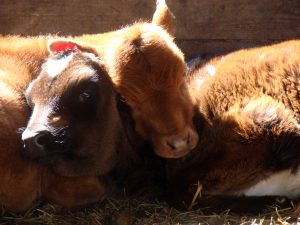Early removal of the calf from its mother is common practice and according to a survey conducted by USDA’s National Dairy Heifer Evaluation Project (NDHEP), 28% of producers removed the calf immediately, 39.6% within 12 hours of birth and 10.4% within 12-24 hours of birth. Reasons for early removal was to reduce prevalence of diseases, ensure colostrum intake and reduce stress for mother and calf so they wouldn’t have much time to bond. Colostrum is the first, thick milk produced and contains important immunoglobulin’s which must be absorbed in order for immunity system to develop in the calf. Some studies have shown that calves often do not ingest enough colostrum to achieve this immunity so hand-feeding colostrum ensures they receive adequate intake.
Studies in favor of early separation point out lower incidence of diseases. One such study by Gulliksen et al states that calves which were kept with their mother for the first week had significantly increased probability to develop respiratory disease which greatly increased risk of mortality. Many other studies also show increased exposure to pathogens and insufficient colostrum intake if the calf stays with its mother for more than 24 hours, thereby increasing risk of mortality. Producers also believe this early separation technique to be more compassionate. Studies have shown that the longer the calf stays with its mother, the more frequent and intense the vocalization, a sign of discomfort, by both calf and dam following separation. A study by Stehulova et al, revealed that calves had increased heart rates for longer duration and more agitated movements if separated at 4 and 7 days which indicates greater stress.
However, other studies reveal that leaving the calf with its mother for longer periods of time has important benefits such as improved social behaviors and weight gain. In a study by Flower and Weary, calves which remained with the dam for two weeks expressed more social behaviors toward new calves such as licking and rubbing heads. Additionally, other studies show that allowing the calf to suckle and stay with its mother increases absorption of immunoglobulins and lowers risk and severity of scours. Staying with the mom is also vital to stimulate calf activity, protect from cold stress as well as feed and comfort the calf.

